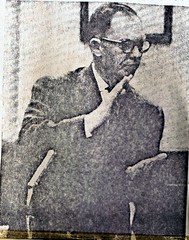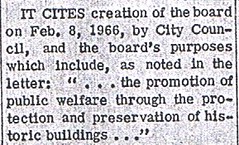 The origin of the group that would become PHW had two concurrent strains of activity: a group of private citizens concerned with the demolition of historic structures, and the advocacy efforts spearheaded by Carroll Henkel for Winchester City Council to enact ordinances designed to protect buildings considered worthy of preservation.
The origin of the group that would become PHW had two concurrent strains of activity: a group of private citizens concerned with the demolition of historic structures, and the advocacy efforts spearheaded by Carroll Henkel for Winchester City Council to enact ordinances designed to protect buildings considered worthy of preservation.
The exact date of the private citizens coming together to form a grassroots organization is lost in the mists of time, but evidence reveals that the first open meeting of this sort was held in November 1963 at the Handley Library. The oldest recorded minutes in PHW’s possession date from January 20, 1964 and set forth the first leaders: Carroll Henkel, President (elected in absentia); Nancy Pennypacker, Vice President; Miss Robert “Bobbie” Y. Conrad, Secretary; and Emily Kuykendall, Treasurer. Others in attendance include Eve Kennedy, Eleanor Rodman, Mary Henkel, T.G. Scully, and absentee dues submitted by Dorothy Allen and Ben Belchic. Enough dues were raised at the meeting to allow the group to join the National Trust for Historic Preservation. The first item of business undertaken was to prepare for a public meeting on February 19, 1964, hosting Helen Duprey Bullock of the National Trust to speak about preservation and its potential to make residences useful in a business district, as well as discussing the Alexandria Ordinance and the Beacon Hill Architectural Commission and how those could be adapted for Winchester. (1)(2)(3)
 The minutes make mention of the similar citizen committee on historic preservation appointed by Mayor Charles B. Smalts, consisting of “Mr. Henkel, Mr. Scully, Mr. Stratton, Irvin O’Connell, and Lewis Barton.” In February 1963, Winchester City Council appointed this committee to make a report on what criteria should be used to determine whether a building was worthy of retention. The group returned to City Council in March with the recommendation to retain all structures that were built prior to 1860 within the original town as laid out by James Wood.*
The minutes make mention of the similar citizen committee on historic preservation appointed by Mayor Charles B. Smalts, consisting of “Mr. Henkel, Mr. Scully, Mr. Stratton, Irvin O’Connell, and Lewis Barton.” In February 1963, Winchester City Council appointed this committee to make a report on what criteria should be used to determine whether a building was worthy of retention. The group returned to City Council in March with the recommendation to retain all structures that were built prior to 1860 within the original town as laid out by James Wood.*
Minutes from March 3, 1964 indicate the grassroots group, 37 members strong, changed its name to Historic Winchester, Incorporated and began the process of incorporation and seeking non-profit status with the mission being “to preserve the aspect of Winchester as a beautiful city by encouraging the conservation and restoration of such buildings as are historically or architecturally significant.”
Little PHW activity was recorded after March 1964. Although the organization remained in existence, no minutes and few files remain in PHW’s possession to document the group’s activities from late 1964 until 1967. Some work, however, must have occurred. An ordinance similar to those explained by Helen Bullock was considered the top priority for the group to present to the City. Bobbie Conrad volunteered to survey the buildings predating 1860 in conjunction with the committee’s recommendation that all such buildings be preserved.(4)
 The Winchester Board of Architectural Review (BAR) was established in February 1966, shortly before the passage of the National Historic Preservation Act in October 1966.(5) Once again, Carroll Henkel was elected to lead the first Board of Architectural Review.(6) The function of the board seems to be much the same as the BAR of today, with the BAR providing an extra layer of oversight and protection to a select number of historic properties. Mention is made in 1969 of a “voluntary list” of houses under BAR purview, along with an “inventory . . . of historic or architecturally interesting buildings” which was different from the voluntary list.(7) PHW minutes from February 26, 1970 clarified that the BAR had submitted a roster of 110 buildings deemed worthy of preservation, likely compiled from PHW members’ work, but that the City had pared the list down to only 16 buildings which had opted-in through the historic marker program. The Conrad House, of course, had been noted in the first list but had not received a marker through the voluntary list and was thus deemed ineligible for BAR oversight in 1969.
The Winchester Board of Architectural Review (BAR) was established in February 1966, shortly before the passage of the National Historic Preservation Act in October 1966.(5) Once again, Carroll Henkel was elected to lead the first Board of Architectural Review.(6) The function of the board seems to be much the same as the BAR of today, with the BAR providing an extra layer of oversight and protection to a select number of historic properties. Mention is made in 1969 of a “voluntary list” of houses under BAR purview, along with an “inventory . . . of historic or architecturally interesting buildings” which was different from the voluntary list.(7) PHW minutes from February 26, 1970 clarified that the BAR had submitted a roster of 110 buildings deemed worthy of preservation, likely compiled from PHW members’ work, but that the City had pared the list down to only 16 buildings which had opted-in through the historic marker program. The Conrad House, of course, had been noted in the first list but had not received a marker through the voluntary list and was thus deemed ineligible for BAR oversight in 1969.
In 1967, the name was changed to the now-familiar Preservation of Historic Winchester, Inc. in an effort to avoid confusion with the Winchester-Frederick County Historical Society. The first historic plaque designating a building for protection was erected that same year. PHW was incorporated in 1968, though 501(c)3 non-profit status was not achieved until 1975. The change in name also marked a change in strategy: mobilizing the town in peaceful protest of the impending destruction of the Conrad House.
* Refer to Winchester Evening Star on February 20, 1963 “Name Committee to Preserve Historical Sites” and March 13, 1963 “Save All Pre-1860 Houses, Special Group Asks Council.” The 2011 architectural inventory indicates 274 structures were constructed between 1750-1860 in the current Winchester Historic District.